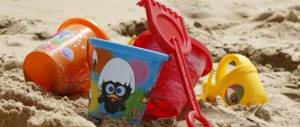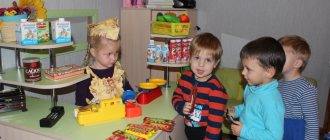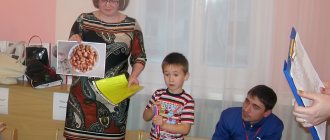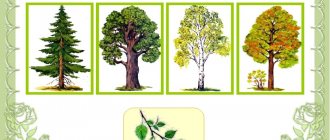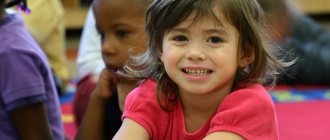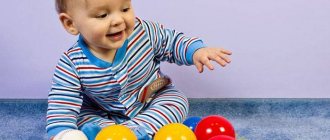Goal: to practically use didactic games and gaming techniques during speech correction work aimed at the most effective activation, clarification, and enrichment of the vocabulary of middle preschool children suffering from motor alalia.
Tasks:
— enrichment, clarification and activation of word formation in children's vocabulary;
– enrichment, clarification and activation of children’s verbal dictionary;
— enrichment, clarification and activation of the vocabulary of nouns in children;
- enrichment, clarification and activation of the vocabulary of adjectives in children;
- enrichment, clarification and activation of the numeral in children;
- learning to understand and use prepositions and particles in speech.
Didactic games and gaming techniques specially selected and developed by us
meet the tasks that are solved by the previously mentioned directions and methods of logocorrection work.
The set of games presented below offers gaming techniques for practical familiarization of children with the use of nouns in speech, introduces children to the concept of “word,” and teaches children to distinguish between the concept of “living” and “non-living.” At the same time, the game gives the speech therapist the opportunity to set an additional goal for himself, for example, grouping objects according to their characteristics or purpose, working on different types of meaning of a word (conceptual, situational, emotional). These games teach children to use the plural of nouns, distinguish the gender of nouns, and are also aimed at creating and consolidating generalizing concepts. These games also teach the use of case forms.
Who is this? What is this?
Goal: clarification, enrichment of word formation in children's vocabulary, teaching children to correctly use in speech words denoting living and inanimate objects.
Equipment: living or non-living objects. (Table, book, toys, birds, fish, etc.)
Game description:
The speech therapist addresses the children: “There are many different objects around us. And we can ask about each of them. I will ask you, and you answer me with a question: “What is this?” The speech therapist points to various inanimate objects: books, toys, table. “How can you ask about these items?” (What is this?)
The speech therapist says: “And now I’ll ask you differently: who is this?” The speech therapist points to living objects: a bird, a fish, a nanny, children - and asks the children: “how can you ask? (Who is this?) I will name you various objects, and you will ask me questions about these objects.” The speech therapist names living objects, and the children ask the question “who?” In this way, the speech therapist gradually leads children to the concepts of “living” and “non-living”.
The speech therapist puts a girl and a doll next to each other and asks how the girl differs from the doll. Children name the difference and together come to the conclusion that the doll is not alive, a toy, and the girl is a living creature. Next, compare the toy bear and the living bear drawn in the picture. It becomes clear that the bear toy is not alive, and the drawing depicts a living bear. To summarize, the speech therapist concludes: all words denoting inanimate objects answer the question “what?”, and words denoting living objects answer the question “who?”
Didactic games to enrich vocabulary
Important: enriching children’s vocabulary is the main thing parents should work on. It must be remembered that adults are an example for children, and in those families where they speak a rich literary language, the child will have correct, well-developed speech. There is no need to wait for a certain age; even as an infant, loved ones can talk about objects in the world around them. This is how the child’s passive vocabulary accumulates, which will then turn into active.
The accumulation of a preschool child’s passive vocabulary should include words denoting objects in the surrounding world, their properties, purpose, and interrelationships. In addition, it is necessary to activate the vocabulary by all means so that the child can use a large number of words in spoken language. For this purpose, educational games to expand quantitative vocabulary and consolidate the lexical meaning of a word are suitable for home learning.
"Bag of Words"
A popular game like the “wonderful bag” helps to accumulate the vocabulary of preschool children and teach them to match a word and an object. It can be carried out with children of all ages; the difference in each age group will be the complication of the vocabulary. Younger children fix the names of objects, older children pay more attention to the properties and purpose of objects, their relationships. The presenter prepares a beautiful bag into which small toys familiar to children are placed. The child must feel the object in the bag and name it, for example, ball, spoon, string, cube. Then the object is pulled out of the bag and it is checked whether the child named it correctly.
At an older age, the rules become more complicated: you need to feel and get the item according to the description. For example, the presenter gives the task: “Find something round, smooth, like a bagel, you can put on your finger (ring)” or “A soft, fluffy lump loves milk very much (toy kitten)”, or “Long, heavy, metal (spoon)” . Having taken out the object, the child must add other properties (color, shape, purpose). If the game is played in a subgroup of children, the one who correctly found and named all the objects wins.
“This place is called...?”
An educational game that teaches a child to understand the lexical meaning of a word. It is useful because you can play in any environment: during a walk, in the country, at home. The adult names a common concept, and the child gives it a name. For example, the place where children study (school); where kids make Easter cakes (sandbox); where books are issued for reading (library), where people come to watch films (cinema). Be sure to reward the child who understands and names all the words. For kids, the game will still be difficult, so you can start with middle preschoolers of four or five years old.
“Which is correct?”
A humorous game, similar to the previous one in terms of the task: you need to choose the correct interpretation of the word, for example, is a spoon an object for digging earth? for drawing? for food? Is a chair a sleeping object? for driving on the road? for sitting? Is a watering can a drinking object? for watering flowers? for storing buttons? Such funny concepts will amuse the child and help to correctly understand the lexical concept.
“Guess what it is?”
The goal of the game is to correctly identify an object by its parts. For example, the presenter says: “Cabin, propeller, engine, wings, landing gear (aircraft); body, engine, wheels, steering wheel, headlights (car); walls, roof, windows, foundation, pipe, door (house); sidewalks, roadway, pedestrians, cars (road).” In a game for kids, you can use pictures to support visual material. Older children work on auditory perception.
“What did the artist forget?”
The game helps to consolidate the names of parts of objects and activate children's vocabulary. An adult prepares pictures depicting objects that are missing some parts: a house has windows, a chair has legs, a teapot has a lid, a bag has handles. The child must correctly name the missing part and complete it. For older children, you can gradually complicate the plot of the pictures and increase the number of missing details, for example, tea utensils on the table.
“Subject lotto (domestic and wild animals, dishes, flora, transport, furniture, clothing and other topics)”
All kinds of lotto-type tasks provide excellent material for enriching your vocabulary and learning new words. The rules are simple: children are given large cards, the presenter takes small cards one by one and names them. Children try to find the corresponding item on their card and close it. The one who collects the big cards the fastest wins. As a more complicated option for the development of auditory perception, the presenter does not show small pictures, but names them.
This is how educational games are played:
- “Who screams: the dog barks, the cat meows, the rooster crows, the cow moos,”
- “Who has what kind of house: the bear has a den, the mouse has a mink, the bird has a nest?”
- “Whose baby: a cow has a calf, a sheep has a lamb, a goat has a kid, a dog has a puppy, a bird has a chick.”
They make it possible to consolidate in children’s speech the names of animals, their cubs, habits, and habitat. The rules are similar to previous games: find the corresponding picture among others. You can maintain interest in rather monotonous actions with riddles. For example, “guess to find the correct picture”:
Yesterday I spent the whole day preparing the den, raking in a little bit of leaves and moss. I worked for a long time, fell down exhausted, and in the evening I applied a bunch of grass (the bear).
A hummock ran past a stump. And the hummock has a black nose and its back is covered in thorns. On the thorns of leaves from oak and aspen (hedgehog).
How quiet it is in the autumn forest! A moose goes out to graze. And behind her, between the pines, a little one gallops... (calf).
Under the bushes at the edge I see gray ears. They stick out from the grass, Little ears... (bunny).
Here sits a little ball of fluff. Nose, black ear. And if you let him go onto the lawn, Strekach will ask like a little bunny.
Piglet and tail crochet. Of course you know him. He is a big pig's child, and his name is ... (pig).
Look at the pictures
Goal: to consolidate in children’s speech words denoting living and inanimate objects.
Equipment: subject drawings depicting living and inanimate objects, flannelgraph.
Game description:
The speech therapist puts all the subject pictures on the flannelgraph and asks the children to look at them carefully. After this, the speech therapist gives the following tasks:
1) name pictures depicting living objects, ask questions about them;
2) name pictures depicting inanimate objects, pose a question.
Complicating the game: the game is played without relying on drawings. The speech therapist selects different words (living and non-living) and names them mixed. Children should pose a question to these words. The most active ones are noted at the end of the game.
Card index of games for vocabulary development
Game “What is it made of?” Target:
consolidating the use of relative adjectives and methods of their formation in children’s speech.
Progress of the game.
Here is an object, but what did people make it from? Parents, throwing the ball to the child, say: “Boots made of leather,” and the child, returning the ball, answers: “Leather.” Parents: fur mittens... Child: fur; copper basin... copper; plush bear... plush; mittens made of wool... wool; glass glass... glass; crystal vase... crystal. You can invite children to make sentences with these word combinations.
Game “Catch and throw - name the colors” Purpose:
selection of nouns for the adjective denoting color.
Reinforcing the names of primary colors, developing children's imagination. Progress of the game.
What color we have - we will tell you about it. Parents, throwing the ball to the child, name an adjective denoting color, and the child, returning the ball, names a noun that matches this adjective. Parents: red - Child: poppy, fire, orange flag - orange, carrot, dawn; yellow - chicken, sun, turnip; green - cucumber, grass, forest; blue - sky, ice, forget-me-nots; blue - bell, sea, ink;
Game “Third extra” (“Fourth extra”) Purpose:
strengthening children’s ability to identify common features in words and develop the ability to generalize.
Progress of the game.
We are now recognizing what is superfluous to us. Parents, throwing a ball to their child, name three or four words and ask them to determine which word is the odd one out. For example: Blue, red, ripe. Zucchini, cucumber, lemon. Cloudy, stormy, clear. Autumn, summer, Saturday, winter. Monday, Tuesday, summer, Sunday. Day, night, morning, spring. The child, throwing the ball back, names the extra word.
Game "Whose head?" Target:
expanding children's vocabulary through the use of possessive adjectives.
The correct use of all these various endings in speech is achieved by repeated repetition of words in game situations. Progress of the game
Whose head is on the beast?
Tell me the words quickly. Parents, throwing the ball to the child, say: “A crow has the head...”, and the child, throwing the ball back, finishes: “... a crow.” Examples: a lynx has a lynx's head for a fish - a fish's head for a cat - a cat's head for a magpie - a magpie's for a hare - a hare's for a rabbit - a rabbit's for a camel - a camel's Game "What is round?" Goal:
expanding children's vocabulary through adjectives, developing imagination, memory, and dexterity.
Progress of the game
Here, of course, everyone knows what happens with us.
When throwing the ball to the child in various ways, parents ask a question, which the child, having caught the ball, must answer and then return the ball. • 1. What is round? (Ball, ball, wheel, sun, moon, apple, cherry...) • 2. What is long? (Road, river, rope, thread, ribbon, cord...) • 3. What is tall? (Mountain, tree, person, house, closet...) • 4. What is green? (Grass, trees, bushes, grasshoppers, dress...) • 5. What is cold? (Water, snow, ice, dew, frost stone, night...) • 6. What is smooth? (Glass, mirror, stone, apple...) • 7. What is sweet? (Sugar, sweets, pies, cakes, waffles...) • 8. What is wool? (Dress, sweater, mittens, gloves, hat...) Game “One - Many” Goal:
to consolidate various types of endings of nouns in children’s speech.
Progress of the game
We are little wizards: there was one, but there will be many.
Parents throw the ball to the child, calling singular nouns. The child throws the ball back, naming the plural nouns. You can throw the ball with hits on the floor, roll the ball while sitting on the carpet. Examples: Table - tables courtyard - courtyards nose - noses mountain - mountains hole - holes bridge - bridges house - houses eyes - eyes. Game “Fun Counting” Goal:
to consolidate the agreement of nouns with numerals in children’s speech.
Development of dexterity and reaction speed. Progress of the game.
We always know how many there are.
Okay, we all think so. Parents throw the ball to the child and say a combination of a noun with the numeral “one”, and the child, returning the ball, responds with the same noun, but in combination with the numeral “five” (or “six”, “seven”, “eight”...) . First, it is better to name combinations based on the similarity of the endings of nouns. Examples: one table - five tables one cabinet - five cabinets one goose - five geese one swan - five swans The parent throws the ball and says: “I have one table.” The child, throwing the ball back, replies: “And I have five tables.” Game "Where is the ball?" Goal:
to consolidate the correct use of prepositions in children’s speech, to develop the ability to navigate in space and attention.
Progress of the game Option 1.
Ball, ball, where are you lying?
You won't run away from us. The child performs the task with the ball: “Raise the ball above your head, put the ball at your right foot, put the ball on the carpet, in front of you,” etc. Option 2.
The child answers the question: “Where is the ball?” (on the table, on the floor, in the corner, near the table, under the table...)
What did they hide?
Goal: enrichment, activation and clarification of word formation in children’s vocabulary and correct use of nouns in speech.
Equipment: dummies of vegetables, fruits, flowers.
Game description:
Flowers, vegetables and fruits are laid out on the table. (2-3 pieces) Children are asked to carefully examine what is on the table and remember what is where. Then the children turn away, and the speech therapist hides one object. The child must answer what is hidden. (You can answer in one word)
Name what I point to
Goal: enriching and activating the word formation of children’s vocabulary and teaching them the correct use of nouns.
Equipment: real and toy furniture.
Game description:
The teacher seats the children so that they can see individual pieces of furniture in front of them and asks them to name them. If this is difficult, the speech therapist himself names the object and invites one of the children to move, for example, a doll, to the sofa, etc. Then you can offer a riddle: “A boy came to kindergarten, sat down and invited another boy to sit down next to him. What were they sitting on? (On the bench, on the sofa)
Games for the formation of sound culture
In kindergarten, in preparation for school, much attention is paid to improving preschool children’s sound pronunciation in accordance with the norms of their native language, which implies the ability to perceive and reproduce all sounds, work with words, control the volume and speed of speech, use intonation for expressiveness, and logical stress. All these skills make it possible to successfully study reading, writing, and competently perform dictations and creative work at school. What didactic games for speech development in preschoolers can be offered for home use?
"Verbal Chain"
The game develops auditory perception and the ability to manipulate words. The rules are similar to the well-known city game. The participants stand in a circle, the leader begins the game with a word, throwing the ball to the player. with a word starting with the last sound of the previous one, for example, do m - mysh - shuba - a rbuz - gold , etc. The main thing is that the players must clearly pronounce the word and highlight the last sound .
"Say the word"
The goal of the game is similar to the previous one: the development of auditory perception. An adult throws a ball to a child with a syllable, and he must continue the word and return the ball. For example, le - summer , zi - winter , no - no , honey - honey , after all. Words are selected from two syllables; the child’s desire to find several options is definitely welcomed, for example, le - summer, laziness, babble, sculpt.
"We're settling the houses"
The game teaches preschool children to identify syllables and helps them pronounce sounds correctly. It is better to play individually with your child to get a good result. To maintain the interest of even small children, an adult can use the game moment: different words and pictures come to visit and want to live in houses (drawn or built from cubes). In a house with one window there will be words with one syllable, and with two windows - two-syllable words. For example, a child clearly pronounces the words “cat, hedgehog, wolf, elk, lynx, mole; squirrel, fox, cat, hare, honey, woodpecker, boar, owl (you can use pictures from “Loto”). As an option, a mix (mixture) of pictures of different subjects is used. To complicate the game with older preschool children, riddles are introduced, and then a picture answer is found.
Who will bring the items faster?
Goal: clarification and activation of word formation in children. Development of skills for classifying lexical topics “Vegetables and fruits”.
Equipment: dummies of vegetables and fruits.
Game description:
Players sit on chairs, 2 chairs are placed opposite them, 5-6 items from two different categories are placed on them: vegetables - carrots, cabbage, cucumber; fruits – apple, pear, cherry. Two empty chairs are placed at a distance. Two children from each team stand near the chairs with objects and at the signal: one, two, three - take the vegetables! - they begin to transfer the necessary objects to the empty chairs standing opposite. The winner is the one who transfers all the objects that belong to the named category more accurately and earlier and names them.
How do we dress?
Goal: activation of word formation with words on the lexical topic “Clothing”. Teaching the correct use of nouns in speech.
Equipment: items of children's clothing.
Game description:
Each child comes up with some item of clothing, for example, a scarf, a skirt, panties, a T-shirt, and quietly names it to the speech therapist so that other children do not overhear. (The teacher makes sure that the children do not choose the same thing) Then the teacher talks about something, for example: “Vasya was going sledding and put it on...” interrupting the story, he points to one of the participants in the game. He names the item of clothing he has in mind. Other children must judge whether the boy is dressed correctly.
